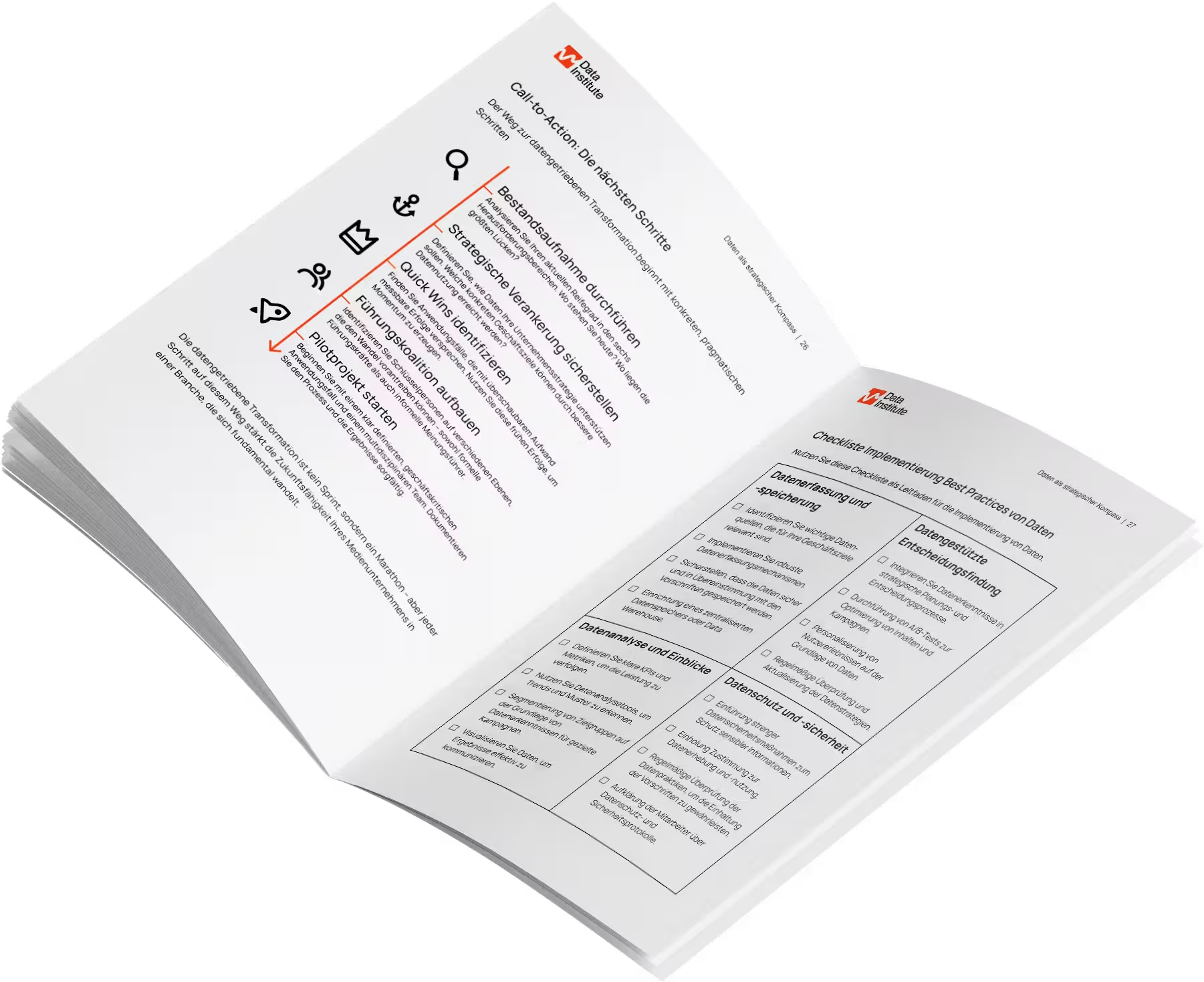Proper use of data consulting in the media environment


The roadmap for data-driven transformation
The ePaper shows you strategies, success stories and a checklist for a direct start into the digital future.

- Das ist eine H2
- Das ist eine H3
In order to survive and grow in this competitive environment, media companies must adapt their organization, culture and IT architecture to the new requirements. Data consultancies with experience in transforming media groups and publishers play a central role here. They can contribute an external perspective and the knowledge already gained and act as trustworthy data consultants.
Current challenges and the role of data consulting
The media industry is facing the following challenges:
- Changing consumption habits: Streaming services, podcasts, and social media have fundamentally changed media consumption behavior. Traditional print subscriptions are declining sharply and must be replaced by other sources of income.
- Increasing competition: New digital players and social media platforms are competing for user attention.
- Technological change: New technologies such as artificial intelligence and virtual reality open up new opportunities, but also new challenges. The often outdated technology and processes in media companies are not prepared for this.
- 360 degree customer profile: In order to understand your customers in the best possible way and to offer meaningful services, an overall view of customers across all channels and data points is necessary. Due to the established structures, this is often not the case and must be built up together.
- Privacy Policy: Laws such as the GDPR place high demands on the handling of personal data.
Data consulting can help decisively here:
- Strategic orientation: Development of a data-driven corporate strategy that is tailored to the company's specific goals and challenges.
- Identification of growth potential: Using data to identify new business models and markets.
- Process optimization: Increasing efficiency through automation and data analysis.
- Minimize risks: Development of measures to comply with data protection regulations and protect against cyber attacks.
Find out more about our services in the area data consulting and data strategy out.
The importance of organization, culture and architecture
In order to make the best possible use of the media company's potential, we rely on the three major aspects as data consulting. In our opinion, this is the only way to take a holistic view and prioritization. Targeted organizational development makes it possible to establish agile structures and cross-functional teams that can react quickly and efficiently to changes. From a cultural point of view, we promote a data-oriented way of working and a willingness to experiment that promotes innovation and learning processes. Finally, we place great value on a solid IT architecture, including cloud-based solutions and strict data governance, to ensure the flexibility and scalability of the data infrastructure. Only by integrating these three components can media companies make the best possible use of their data and achieve their strategic goals.
Organization in media companies
Agile structures: Promoting an agile way of working in order to be able to react quickly to changes. Today's media landscape is characterized by constant change and rapid technological progress, which is why an agile methodology makes it possible to react flexibly and efficiently to new requirements and market changes.
Cross-functional teams: Bringing together experts from various fields to develop holistic solutions. These teams can foster innovation as they combine diverse perspectives and expertise, resulting in more creative and robust solutions.
Data ownership: Clear responsibilities for data quality and use. Assigning data controllers ensures that the data is accurate and up-to-date, which forms the basis for well-founded decisions. It also strengthens accountability and awareness of the value of data within the company. Good data organization is therefore the cornerstone of a successful data strategy, as it forms the basis for efficient use and management of information.
Culture in media companies
In order to develop a data-driven corporate culture, it is crucial that all employees regard data as a valuable resource. This means that everyone in the company must have an understanding of how data can be used and interpreted to make informed decisions and improve business processes. Managers play a central role here by increasing awareness of the importance of data through training and continuing education.
Data orientation: Creating a corporate culture in which data is seen as a valuable resource. This culture ensures that data is viewed as a central part of decision making across the organization, resulting in more informed and strategic business decisions. Training and workshops can help raise awareness of the value of data and get all employees on the same page.
Willingness to experiment: Fostering a culture in which new ideas are tried out and mistakes are seen as a learning opportunity. This mindset encourages employees to develop innovative solutions and use new technologies without fear of potential setbacks. This can be achieved by using pilot projects and sandbox environments where employees can safely experiment to find the best approaches for using and analyzing data. Ultimately, such a culture leads to continuous improvement and greater competitiveness in the dynamic media market.
Data and IT architecture in media companies
In order to fully exploit the potential of a media company, the right architecture of the data infrastructure is crucial. Cloud-based solutions play a central role here, as they not only enable a flexible and scalable IT infrastructure, but also support the integration and analysis of large amounts of data in real time. By using modern cloud technologies, companies can increase agility and efficiency by adapting resources as needed and responding quickly to new requirements. The introduction of data governance is also of great importance; established guidelines and standards ensure that data is consistent, secure and of high quality. Another important aspect is the concept of data mesh, which pursues a decentralized data architecture. This allows different teams within the company to manage and use their own data products, resulting in greater scalability and independence. Overall, these architectural measures form the basis for a successful data strategy in the media sector.
infrastructure: Cloud-based solutions offer the advantage of giving media companies a high level of flexibility and scalability. By using modern cloud technologies, capacities can be quickly adjusted as required, which is particularly decisive in times of high utilization. In addition, cloud-based infrastructures facilitate collaboration across different locations by ensuring access to important data and applications anytime, anywhere.
Data Governance: Introduction of guidelines and standards for handling data. A robust data governance framework is essential to ensure high data quality and security. This includes establishing clear guidelines and standards for handling data to prevent misuse and inconsistencies. With well-thought-out data governance practices, companies can ensure regulatory compliance and earn the trust of their users by managing their data responsibly.
Data mesh: Decentralized data architecture for greater scalability and agility. The data mesh architecture promotes a decentralized approach in which individual teams are responsible for their data products. This approach improves scalability, as individual domains can be developed autonomously without creating central bottlenecks. Decentralizing data management can also increase agility, as teams can react more flexibly and quickly to changes and new requirements.
The future of the media industry: data as a driver
The future of the media industry will be shaped by data. personalization is becoming the standard because it makes it possible to tailor content and advertising specifically to individual preferences and interests. artificial intelligence will help create content, for example by automatically generating texts, analyzing images and editing videos. New business models will emerge that are characterized by data-driven innovations, such as subscription services that offer tailored access to content. In addition, the Real time data analysis play an essential role in making quick and well-founded decisions based on current trends and user behavior. In order to be successful, media companies must therefore have their Data strategies adapt continuously and invest in cutting-edge technologies.
To be successful in this future, media companies must consider the following aspects:
Real-time data analysis: Quick processing of large amounts of data to make timely decisions.
Artificial intelligence: Using AI for tasks such as content creation, personalization, and forecasting.
ethics: Responsible use of data is essential to gain user trust. Furthermore, continuous training of employees in the use of new technologies will be required in order to always stay up to date. Data security plays a central role here, as sensitive information must be protected at all times. Companies should also ensure seamless integration of new technical solutions in order to optimize existing systems and promote innovation. All of these aspects are not only decisive for short-term success, but also for long-term competitiveness in the dynamic media industry.
Conclusion on data as a success for the media industry
Data is the key to success in the modern media landscape. A successful data strategy requires close collaboration between management, IT, and data scientists. One professional data consulting can help companies use their data effectively and thus strengthen their competitiveness. It is not just about the technical implementation, but also about the Training employees and establishing a data-oriented corporate culture. Every team member should understand the importance of data and how it can help achieve business goals. In addition, clear processes and responsibilities should be defined in order to data quality to ensure and ensure that the right data is available at the right time Ultimately, an integrative and continuous data strategy is essential to ensure long-term success and innovative strength in the media industry characterized by rapid change.
Our case studies provide further details and background information about our work in the areas of media, publishing and publishing.
Facing complex compliance and organizational hurdles?We build the robust Data Governance foundation you need.
The Data Institute is your partner for:
- Implementing clear Data Governance Roles (Hub & Spoke Model)
- Establishing cross-organizational processes (e.g., MediaPrint, HAAS, FUNKE)
- Ensuring 100% GDPR-compliance and risk minimization
Take Action: Schedule a Free Data Strategy Consultation
Or start your deep dive: To the Ultimate Guide: Your Roadmap for Data-Driven Success

Data use cases in the media environment
Subscribe to our newsletter and don't miss out on any new insights.
Data use cases in the media environment
Subscribe to our newsletter and don't miss out on any new insights.

Data use cases in the media environment
Subscribe to our newsletter and don't miss out on any new insights.

Related case studies
There are suitable case studies on this topic
Which services fit this topic?

Data consulting is exciting
Stay up to date and subscribe to our newsletter.
Data consulting is exciting
Stay up to date and subscribe to our newsletter.

Data consulting is exciting
Stay up to date and subscribe to our newsletter.








